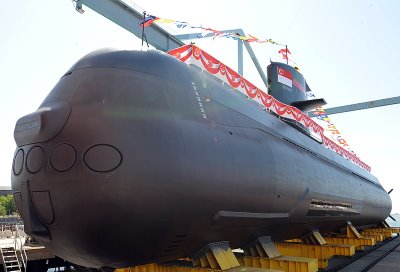Japan outlines SEA1000 Future Submarine bid
by ANZDD on 08-Oct-2015

Speaking at the Pacific 2015 International Maritime Exposition, Japan’s submarine bid team has outlined the details of its proposal for Australia’s SEA1000 Future Submarine program to replace the Royal Australian Navy’s existing Collins-class boats.
Representatives from the Mitsubishi Heavy Industries-Kawasaki Shipbuilding Corporation consortium along with the Japanese Ministry of Defense have confirmed that if Japan is selected to construct SEA1000, the submarines will be built in Australia with Japanese technology transfer.
Masaki Ishikawa, from Japan’s Ministry of Defense, said that the Japanese consortium is “very confident that we can build boats from Day One in Australia.” In such a scenario, the Japanese are proposing that a training center will be set up in Adelaide (in the state of South Australia) to train 300 engineers involved in the program.
In addition, a full-scale mock-up initially will be built by government-owned Australian Submarine Corporation (ASC) in Adelaide to train the Australian submarine workforce. The training is expected to take place over three years, part of which will occur in Kobe, Japan.
However, the Japanese have also suggested that they prefer the hybrid option of initially building some of the Australian submarines in Japan and the rest in Australia, and expect that this will result in Australia taking delivery of the first submarine faster, avoiding the need for building a mock-up for training—saving money in the long term.
The design being offered by the Japanese is a modified Soryu-class diesel-electric submarine, and will run on lithium-ion batteries as opposed to air independent propulsion (AIP). However, AIP could be offered if Australia has such a requirement.
The modified Soryus for Australia will also incorporate a new, Australian-developed hydrodynamic design, while the preferred combat system and a new heavyweight torpedo, which will be the submarine’s primary armament, are being jointly developed by Australia and the United States.
Turning to ASC, the Japanese spoke highly of the Australian shipyard, saying that they thought the Australians had a very good shipyard, but nevertheless adding that ASC will need to upgrade, given that it will be building the largest conventional submarine in the world.
The controversial SEA1000 program has previously been dogged by government instability in Canberra, vaguely defined requirements and the changing security landscape facing Australia over the past few years.
Political pressure soon forced the government to reverse course, instead announcing in February of this year that a “competitive evaluation process” will take place between France’s DCNS, Germany’s ThyssenKrupp Maritime Systems and the Japanese consortium. The three bidders are currently in the process of finalizing their bids, which are due for submission by 30 November.







